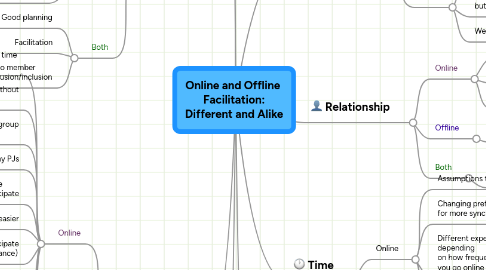
1. Participation
1.1. Online
1.1.1. In asynch, have time to reflect
1.1.2. You can multitask without public visibility
1.1.3. back channel not visible to group (vs whispering in the room)
1.1.4. Can work in my PJs
1.1.5. Asynch may increase number of can participate
1.1.6. Lurking easier
1.1.7. More can participate (over time/distance)
1.1.8. Technology as barrier and enabler
1.1.9. Can take longer to "figure out" particularly the interface
1.1.10. harder to manage balance of public/private (backchanel) communications
1.1.11. Challenge of easier "social loafing" and freeriding
1.2. Offline
1.2.1. Can judge and nudge participation non verbally
1.2.2. Stronger for kinesthetic learners
1.3. Both
1.3.1. Depend on relationship and trust
1.3.2. Thrive of purpose that matters to participants
2. Modalities
2.1. Offline
2.1.1. More "body language" and tone
2.2. Online
2.2.1. Favors writers/ readers, typists
2.2.2. Interfaces create different modality experiences
2.2.3. Distractions amplified
2.3. Both
2.3.1. Has linguistic implications
2.3.2. have distractions, but they are different
2.3.3. We all have our preferences
3. Preparation
3.1. Online
3.1.1. More tech prep and support
3.1.2. have to scaffold both social and technical aspects
3.1.3. Arrange the electrons
3.1.4. you set up space, sometimes metaphorically
3.2. Offline
3.2.1. Arrange the chairs and flipcharts
3.2.2. You set up room/chairs
3.3. Both
3.3.1. Good planning
3.3.2. Facilitation
3.3.3. Issues related to member feelings of exclusion/inclusion
4. Relationship
4.1. Online
4.1.1. takes a while to get to know someone
4.1.2. Judge on words before appearances
4.1.3. Some "hear" the voices
4.2. Offline
4.2.1. Used to making physical judgement (race, gender, "types")
4.3. Both
4.3.1. We can show only parts of our selves if we wish
5. culture
5.1. online
5.1.1. Harder to make visually based ethic judgements
5.2. offline
5.3. both
5.3.1. working across languages can be challenging
6. Time
6.1. Online
6.1.1. Assumptions that online is fast
6.1.2. Changing preferences for more synchronous
6.1.3. Different experiences depending on how frequently you go online
6.1.3.1. can fall behind easier
6.1.4. Synchrony builds more shared context?
6.1.5. can do things in parallel/multi-task
6.2. Offline
6.2.1. Can only be in one place at one time
